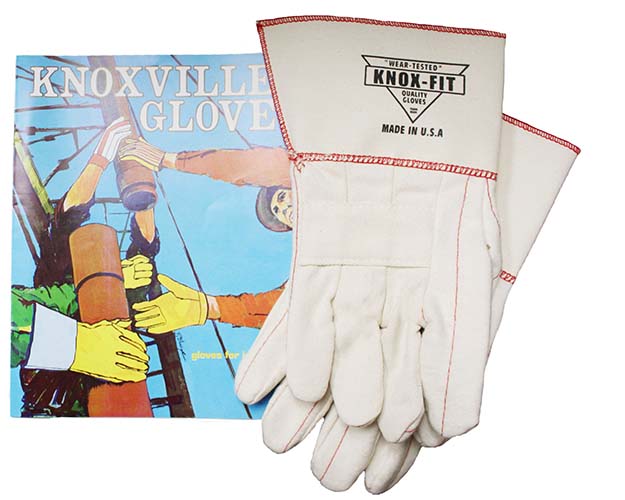800-251-9738 | 865-573-4555 | Fax: 865-573-4558 | sales@knoxvilleglove.net
Material Description: Fabrics

Various fabrics that combine strength and softness are used to manufacture work gloves. The most popular of these is canton flannel; another is knit jersey; a third is terry cloth.
These have been the basic materials for work gloves for the last 100 years. Cuffs for work gloves are made either of knit jersey or various drill materials, laminated with rubber to give them substance and strength.
Canton flannel, the most widely used material, is made of thin strong thread, laid out in warps ten thousand yards in length. The filling used to weave the material is a thick soft yarn. A napper catches the fibers on the filling and pulls them out, giving the cloth a nap, which is soft to the hand. Basically, its purpose is to keep abrasion from the hand. The drill side is usually presented to the work. The material is typically made in widths of 35 inches.
As an industry standard, the most popular is the material weighing 8 ounces for one square yard. Heavier material is available in graduations of 2 ounces, i.e., 10 ounces, 12 ounces, etc. When material is over 12 ounces per yard, it is usually combined with another woven flannel to make double thickness, double palm gloves.
Jersey is much the same, being knit with a combination of this strong yarn and thick soft yarn. It is knit in a tubular form and it is ran through the nappers to give the soft, fleecy feel which is generally used as the inside of the glove.
Terry cloth, on the other hand, is all the same type of yarn and is made in loops to give a cushioning effect to the hand. The loops and twirls tend to prevent edges of steel, burrs, etc. from cutting through as they would a smooth surface, giving added safety.
Material Description: Leather
Much leather has the same appearance, but has very different wearing qualities. The cow hide is generally about 5/8 to 1/2 inch thick. It‘s literally split apart when being tanned. After the hide is split, the outside is called TOP GRAIN leather and the flesh side is called “SPLIT” leather. TOP GRAIN leather has the greater wearing qualities, as the animal’s naturally tough outside has not been altered or otherwise weakened.
Next to the top grain leather, the SIDE SPLIT is the most durable part of the hide. The fibers of the side of the animal are more closely knit and more uniform than those of the shoulder or leg, since these fibers have not been moved back and forth by the action of the animal walking, running, etc.
The “SHOULDER SPLIT” is so named because it is taken from the animal near the shoulder. Here the fibers tend to be more stringy and not as closely knit as those from the side. For these reasons, it does not have the durable wearing qualities of the side-split. The “nap” of the material is longer and coarser than that of the side-split. It is often marked by small “veinings” where the veins, bringing blood to the area of the shoulder, have made small channels in the leather. These are almost never seen in side splits.
In our catalog we have grouped series of gloves together by the material. The different groups are made up of different materials. Within the groups the patterns are very similar, the wrist protection is similar, and the accessories such as tips, elastics, and knuckle straps can be applied to the various basic materials giving a wide variety of styles.
The Knoxville Glove Company has the flexibility to make gloves of other materials or different combinations of these materials already mentioned, using the basic patterns. In order to determine what materials should be used and how they should be combined, the greatest help is to submit used gloves so we can analyze the wear points and do everything possible to minimize this wear. Taking away unnecessary materials is another cost reduction possibility. We welcome your inquiries regarding any safety concerns.
